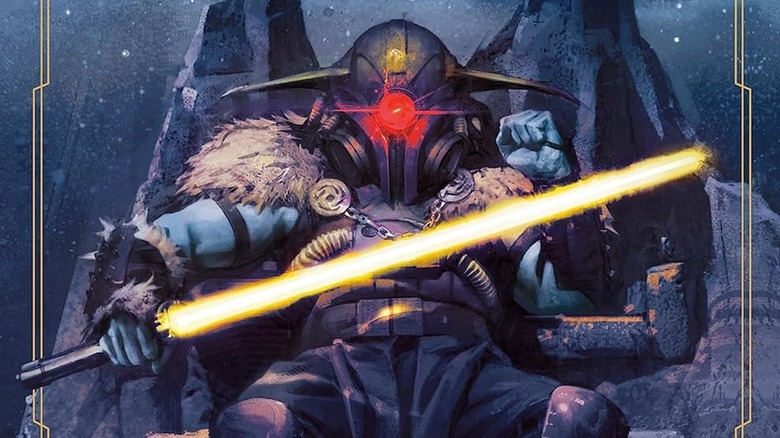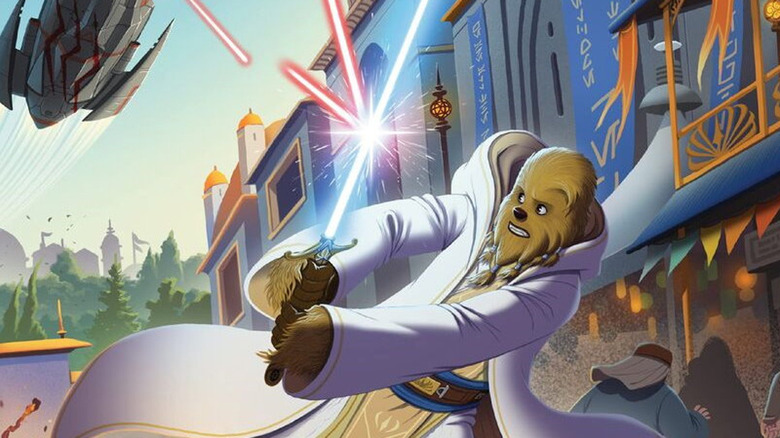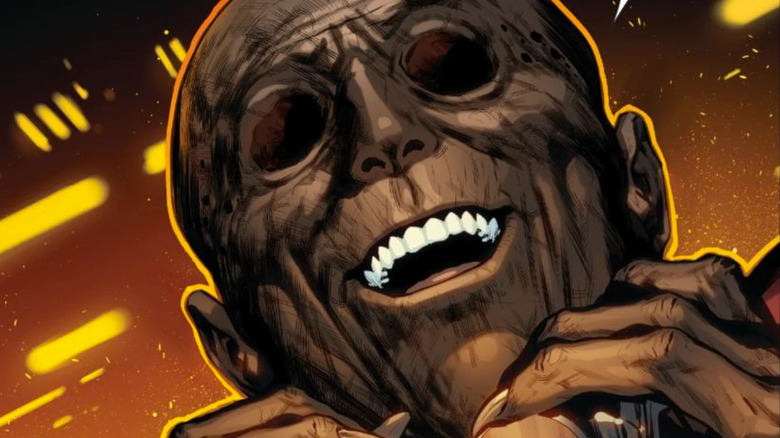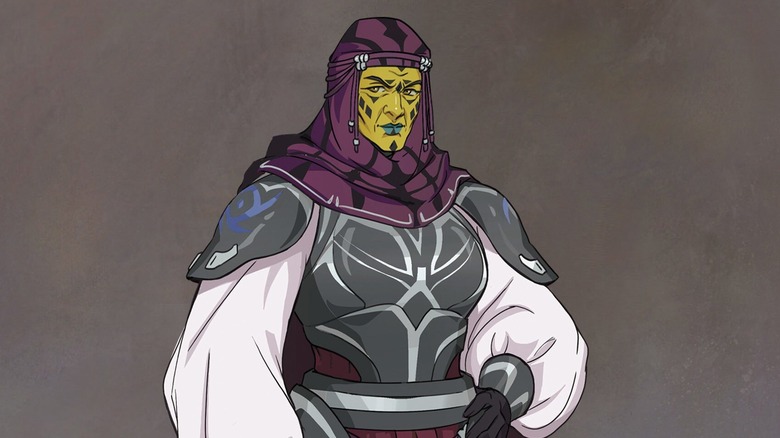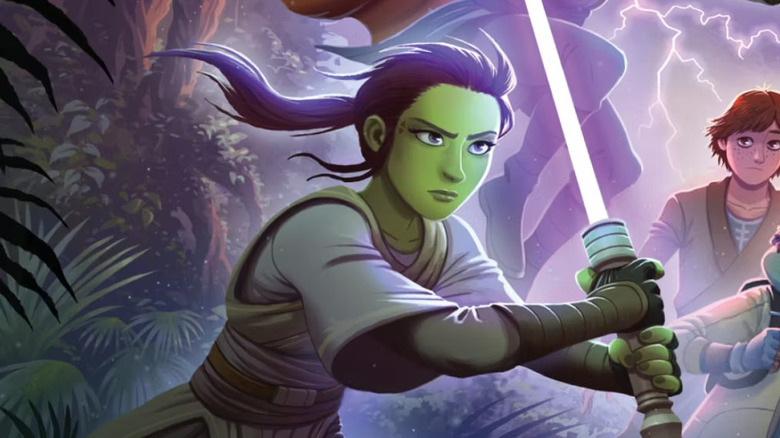The Book Star Wars: The High Republic - The Eye Of Darkness Feels Like A Star Wars Film At Its Best
Warning: This review will contain spoilers for "Star Wars: The High Republic – The Eye of Darkness" by George Mann, which was provided to the author for purposes of review
As the first adult novel in the third phase of Lucasfilm's High Republic initiative, "Star Wars: The High Republic – The Eye of Darkness" by George Mann takes us back to the future. In the first phase of the High Republic, the clock was set back on the "Star Wars" universe about 150 years before the events of "The Phantom Menace." As the Republic is much more of a frontier government, stretching its influence in a galaxy where communication is a little bit more difficult, the Jedi are tested by a group called the Nihil who ultimately destroy their station, Starlight Beacon. It was an attack on the very ideals of the Republic and the foundation of the Jedi. Many Jedi were killed and things were left in a bad way. The second phase of "The High Republic" turned the clock back another hundred and fifty years or so to show the formation of the Nihil and reveal the origins of their secret, Jedi-killing weapons. All the while, the Jedi had a really rough go of it. Phase three skips back ahead to a year or so after the first phase. The Nihil have created an Occlusion Zone — a protected wall of space that Republic ships cannot cross — conquering not just worlds but entire regions of space.
The Jedi are helpless and the Republic has no idea what to do.
We see the story through a number of characters that include, but are not limited to, many Jedi.
Jedi Elzar Mann works the angles with politics on Coruscant, trying to find a way to help the beleaguered Chancellor. Jedi Avar Kriss and Porter Engle are stuck behind the Nihil's hyperspace barrier and work to bring hope to the people under the tyrannical rule of the Nihil. Bell Zettifar and Burryaga the Wookiee patrol the systems at the edge of the Occlusion Zone, hoping to drive away the Nihil attacks, but also steal one of their ships in order to reverse engineer their hyperdrive systems so they can make it beyond the wall themselves with an attack force.
All the while, the Eye of the Nihil, Marchion Ro — the big bad guy in the first and third phases of "The High Republic" — plots against the Jedi from the safety of his new walled, kingdom.
A brisk pace
George Mann threads together a number of different narratives in a compelling way. It was a smart move to skip a year of storytelling and advance the story forward, starting in media res with a new status quo. It forces us as readers to try to catch up, and certain things advance in ways that make us incredibly curious. Burryaga, for instance, apparently died in the crash on the Starlight Beacon, much to the surprise of everyone reading, but here he is again. Eventually, the book gives us an answer, and it's satisfying, but if the narrative had picked up minutes after the end of Phase One, the storytelling wouldn't have been as strong or intriguing.
Mann is also really terrific at weaving the political story with the struggles of the Jedi in a way that moves incredibly fast. The chapters shorten as the narrative goes on and Mann creates the paced feeling of a "Star Wars" film, having all of the disparate threads come together in the same way George Lucas' best efforts have. With such a brisk pace, the book flies by, even though it's long. You're definitely going to get your money's worth on the story.
Azlin Rell
Perhaps the most shocking story that "Eye of Darkness" alluded to but barely elaborated on was the inclusion of a character named Azlin Rell. Azlin Rell was a young Jedi during the second phase of "The High Republic." As a human, one would assume we wouldn't see him again in the third phase, since he would have most likely died of old age.
Add to that the fact that the last time we saw Azlin Rell, he was cowering in fear because of the Nameless — creatures that feed on the Force and cause terror in Jedi — it seemed unlikely he would make it through the ordeal.
Here, though, we skip ahead over many chapters of his life to learn that he's turned to the Dark Side and prolonged his life unnaturally. His thick goggles cover over the fact that he no longer has eyes. His ghastly appearance and descent into darkness make it all the more surprising when he shows up in the Jedi Temple accompanied by Yoda who insists that Azlin can help them solve their Nameless problem, though the rest of the Jedi Council is obviously reluctant.
There is clearly more story here to be told, and I can't wait for more in this particular direction because this is endlessly fascinating to me.
Details to watch out for
As "The Eye of Darkness" picks up after two whole phases of "The High Republic," there is going to be a huge swath of things that connect to other parts of the publishing initiative, but there are some cool details and bits in here that might go by unremarked upon that I'd like to point out.
First, this book talks about the "Jedi Guardian Protocols." This is a protocol that recalls all the Jedi not out on vital missions — something Palpatine tries to fool Jedi into thinking after Order 66 until Obi-Wan Kenobi tells them all to stay away — and also indicates that no Jedi is to travel alone. More than that, it states that for "the first time in generations" Padawans would be fast-tracked to undergo their Trials in order to replace lost Jedi. This all presages the transformation the Jedi undergo during the Clone Wars and they do very similar things, asking us to view this era as, perhaps, the beginning of the Jedi's end.
One character I thought to point out was Baron Boolan, who is Marchion Ro's evil "Minister of Advancement" and works on nefarious experiments to weaponize the ability of the Nameless against the Jedi. The Ithorian Boolan appeared throughout the second phase of "The High Republic" as a child. At the end of "Path of Vengeance," he was tasked along with the other Littles to bomb caverns to kill Jedi and it seems as though his thirst for Jedi death has never been quenched.
You'll also notice the return of Ghirra Starros (the ancestor of the popular comics character and one-time love interest of Han Solo Sana Starros). She's turned her back on her seat as a Republic Senator and has engaged in a relationship with the Eye himself, Marchion Ro. She tries to bring the Nihil to heel and end the death and create a political solution to the war between the Nihil and the Jedi, but she's really only being used by Ro.
Another character with ties to other phases includes General Viess, a Mirialan who has joined the Nihil as the "Minister of Protection." Eagle-eyed fans will recognize her from Charles Soule's "The Blade" comic mini-series that started coming out last year. Viess has a long history with the Jedi Porter Engle and she makes it well known here.
It was also fun to see an Ughnaught character in the form of Belin, who aids Avar Kriss in her journey behind the Stormwall. It is apparently a long, cultural thing for Ugnaughts to say "I have spoken," as Belin does this in the book. Just like Kuiil in "The Mandalorian."
The last character I'd like to point out from other media that appears is the Quermian Jedi Yarael Poof, who first appeared in "The Phantom Menace." Still on the Jedi council so many years later, I found it hilarious that Poof is only ever seen via a hologram in this book with no explanation as to why.
The sprawling nature of the High Republic
I have to say how surprised by how brutal and intense this book was. They are really kicking off the third phase of "The High Republic" with a situation where the villains have the upper hand and only continue to keep it through the course of this book. Things still feel very hopeless for the Jedi in their fight against the Nihil, but we know there's still light at the end of the tunnel. In that regard, the end of the book reminded me a bit of the ending notes of the middle chapters of the Skywalker Saga — "The Empire Strikes Back," "Attack of the Clones," and "The Last Jedi" — where the heroes have been utterly crushed, but there's a moment of optimism at the end where the unity of the characters we care about most carries us to the next installment.
Mann rendered all of that really well.
For many "Star Wars" fans — and many who don't read the books — the biggest question they're likely to have is how this new phase of "The High Republic" is going to connect with the upcoming television series "The Acolyte." There are certainly no hints yet, other than the one character we know about coming to live action: Vernestra Rwoh. Where else will they take us as they lead us to that story? It's still really unclear. But this book was so good and easy to devour, that I am dying for more answers soon.
Perhaps my favorite thing about the "High Republic" publishing program, though, is that just about any time I find myself wondering if there's more depth to a particular story the answer is almost always yes.
"The High Republic" phase three is kicking off now, and it's already proving to be a doozy.
"Star Wars: The High Republic – The Eye of Darkness" is available now wherever you buy books.
